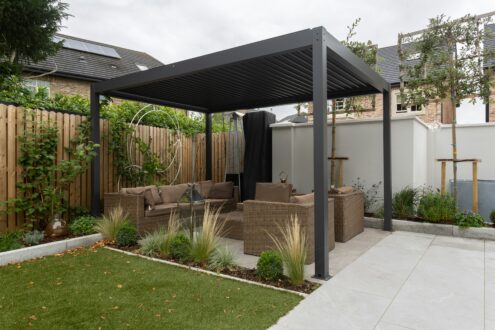Noise reduction solutions have become increasingly important for creating peaceful living and working environments. Soundproof curtains and acoustic panels are two popular options for minimizing unwanted sounds. Both solutions can effectively reduce noise, but their effectiveness depends on the specific situation and requirements.
Soundproof curtains are versatile and easy to install, making them a popular choice for residential settings. They work by absorbing sound waves and blocking external noise from entering a room. Acoustic panels, on the other hand, are typically more effective at managing sound reflections and reducing echo within a space. These panels are often used in studios, offices, and other professional settings where precise sound control is crucial.
When choosing between soundproof curtains and acoustic panels, consider factors such as installation requirements, aesthetic preferences, and the level of noise reduction needed. For those seeking a fabric-based solution, acoustic curtains in the UK are available that have been lab-tested and certified for sound reduction. Meanwhile, in the US, both options are widely available with a range of styles, but acoustic panels often provide more substantial noise reduction due to their rigid material. In Australia, soundproof curtains are popular for their ease of installation and dual functionality, offering both acoustic and thermal benefits. Ultimately, the best choice depends on the specific acoustic challenges of the space and the desired outcome.
Key Takeaways
- Soundproof curtains and acoustic panels offer different approaches to noise reduction
- The effectiveness of each solution varies based on the environment and noise type
- Consider installation, aesthetics, and required noise reduction when making a choice
Comparing Solutions for Noise Reduction
Soundproof curtains and acoustic panels offer distinct approaches to noise reduction. Each solution has unique features and effectiveness for different environments and sound control needs.
Soundproof Curtains: Features and Effectiveness
Soundproof curtains are made from dense, heavy fabrics designed to absorb and block sound waves. They typically feature multiple layers of material, enhancing their noise-reducing properties.
These curtains often provide thermal insulation, light blocking, and sound reduction benefits. Many soundproof curtains, like the Nicetown Thermal Insulated Curtains, offer blackout functionality.
Soundproof curtains are relatively easy to install and can be a cost-effective solution for noise control. They work best for reducing high-frequency sounds and can decrease noise levels by up to 10 decibels.
However, their effectiveness is limited compared to more robust acoustic treatments. Soundproof curtains are most suitable for mild to moderate noise issues in home or office settings.
Acoustic Panels: Design and Noise Absorption Qualities
Acoustic panels are specialized sound-absorbing structures designed to reduce echo and reverberation in a room. They are typically made from dense materials like foam or fiberglass.
These panels are highly effective at absorbing a wide range of frequencies, particularly mid to high-frequency sounds. Acoustic panels can significantly improve sound quality in studios, home theaters, and other spaces where audio clarity is crucial.
Acoustic panels are rated using the Noise Reduction Coefficient (NRC), which measures their sound absorption efficiency. High-quality panels can have NRC ratings of 0.8 or higher, indicating excellent absorption.
Unlike curtains, acoustic panels require more permanent installation and may alter room aesthetics. They are often more expensive than curtains but provide superior sound control, especially for low-frequency noise and complex acoustic issues.
Determining the Best Choice for Various Environments
Selecting between soundproof curtains and acoustic panels depends on specific environmental factors, budget considerations, and intended use. Each option offers distinct advantages for different settings.
Environmental Considerations for Installation
Acoustic panels excel in spaces with hard surfaces like concrete or drywall. They attach directly to walls, ceilings, or floors, effectively absorbing sound waves. Panels work well in music studios, conference rooms, and home theaters where precision sound control is crucial.
Soundproof curtains are more versatile and portable. They hang easily on existing curtain rods, making them ideal for renters or those seeking a temporary solution. Curtains prove effective in bedrooms, living rooms, and offices, especially near windows where external noise penetrates.
The material composition matters. Wool or polyester blend curtains offer better sound absorption than lightweight fabrics. Dense acoustic panels made from specialized materials outperform curtains in overall noise reduction.
Evaluating Cost, Convenience, and Overall Impact
Soundproof curtains generally cost less than acoustic panels, making them a budget-friendly option. Installation is simple – most people can hang curtains without professional help. However, their effectiveness varies widely based on quality and thickness.
Acoustic panels require a larger upfront investment. Professional installation often yields best results, adding to the cost. Yet panels provide superior sound control, especially for low-frequency sounds and vibrations that curtains struggle to dampen.
For long-term solutions, acoustic panels offer better value. Their durability and effectiveness justify the higher initial expense. Curtains suit temporary needs or situations where frequent rearrangement is necessary.
Selecting for Specific Use Cases: Residences and Commercial Spaces
In homes, soundproof curtains often suffice for general noise reduction. They work well in bedrooms to block traffic noise and improve sleep quality. Home offices benefit from curtains’ dual function of light and sound control.
Acoustic panels shine in dedicated home studios or theater rooms. They provide precise sound shaping, enhancing audio quality for music production or movie viewing. Panels also work well in shared living spaces to reduce noise transmission between rooms.
Commercial spaces like restaurants or open-plan offices often require a mix of solutions. Acoustic panels on walls and ceilings absorb ambient noise, while soundproof curtains near windows or as room dividers offer flexibility. Conference rooms benefit from panels’ superior speech clarity.
Theaters and music venues rely heavily on acoustic panels for optimal sound quality. The ability to fine-tune acoustics with panel placement and density is crucial in these environments.

Photo by Priscilla Du Preez on Unsplash
Conclusion
Soundproof curtains and acoustic panels both offer noise reduction benefits, but serve different purposes. Acoustic panels excel at absorbing sound within a room, improving audio quality and reducing reverberation. Soundproof curtains primarily block external noise from entering a space.
The choice depends on specific needs. Acoustic panels provide superior sound control for professional studios or home theaters. Soundproof curtains offer a more affordable and flexible solution for bedrooms or offices needing general noise reduction.
When deciding between these options, consider factors like budget, installation requirements, and desired noise reduction levels. Combining both methods can create a comprehensive sound management strategy for optimal results in any space.











Leave a Reply